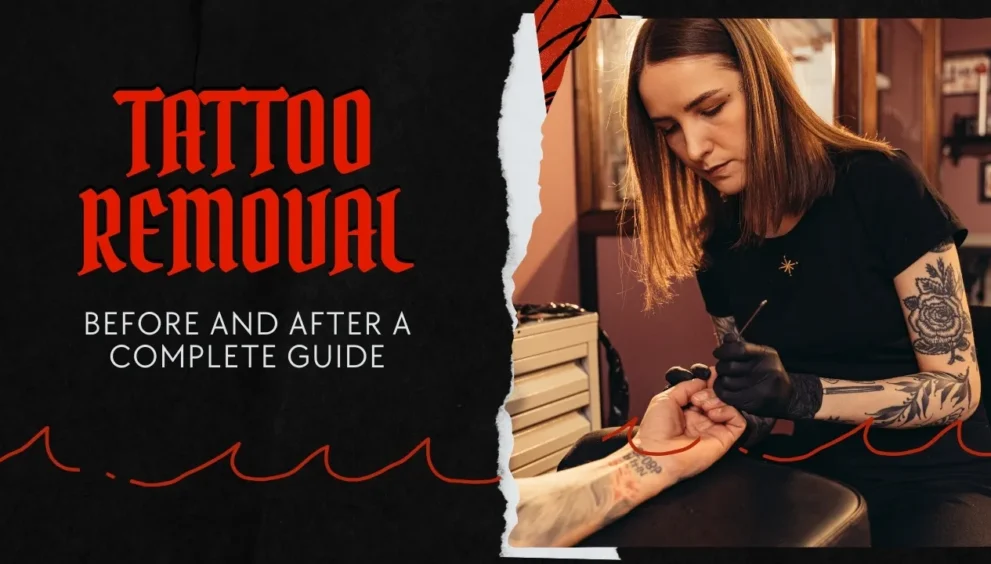Tattoo Removal Before and After: A Complete Guide

Getting a tattoo can be a meaningful decision, but not all tattoos age well or remain relevant over time. Tattoo removal has become a popular solution for those looking to erase or lighten their ink.
This article will guide you through the process of tattoo removal, highlighting its methods, results, and factors influencing success.
What is Tattoo Removal?
How Does Tattoo Removal Work?
Tattoo removal breaks down the ink particles embedded in the skin. Methods like laser treatment use high-intensity light to shatter these particles into smaller fragments, which are naturally removed by the body.
Non-laser options, such as dermabrasion or surgical excision, physically or chemically remove tattooed layers of the skin.
Why Do People Choose Tattoo Removal?
Common reasons include a change in personal taste, career considerations, or wanting to fix or remove poorly done tattoos. Some seek removal to lighten existing ink for a cover-up tattoo.
Types of Tattoo Removal
Laser Tattoo Removal
Laser treatments, like Q-switched lasers or PicoSure, are the most common methods. These use targeted light beams to break up tattoo ink without damaging surrounding skin.
Non-Laser Options
- Dermabrasion: Sanding the skin to remove layers.
- Chemical Peels: Using solutions to break down tattooed skin.
- Surgical Excision: Cutting out the tattooed area and stitching the skin.
Each option varies in effectiveness, cost, and recovery time.
How Long Does Tattoo Removal Take?
Number of Sessions Needed
The number of sessions depends on factors like tattoo size, ink colors, and depth. Small, simple tattoos may take 4-6 sessions, while larger or more colorful designs require 10 or more sessions.
Time Between Sessions
Typically, sessions are spaced 6-8 weeks apart to allow the skin to heal and the body to flush out fragmented ink particles.
What Influences Tattoo Removal Results?
Skin Tone and Type
Lighter skin tones often experience faster results as the laser can focus directly on the ink. Darker skin tones require more care to avoid skin damage.
Ink Colors
Black and dark blue inks are the easiest to remove. Colors like green, yellow, and orange are more resistant and may require advanced lasers.
Tattoo Age and Depth
Older tattoos often fade quicker because the ink has naturally degraded. Deeper or professionally done tattoos are more challenging compared to shallow or amateur ones.
Tattoo Removal: Before and After Care
Preparing for the Procedure
- Avoid sun exposure for 2-4 weeks before your appointment.
- Do not apply creams or lotions to the tattooed area before treatment.
- Shave the area if necessary, but avoid waxing or other skin treatments.
Post-Procedure Care
- Keep the treated area clean and dry.
- Use prescribed ointments to prevent infection.
- Avoid sun exposure to reduce the risk of scarring.
Risks and Side Effects of Tattoo Removal
Common Side Effects
- Redness and swelling around the treated area.
- Temporary blistering or scabbing.
- Skin discoloration, especially for darker skin tones.
Long-Term Risks
- Minor scarring.
- Hypopigmentation or hyperpigmentation.
- Rare infections if aftercare instructions are not followed.
Benefits of Tattoo Removal
| Pros | Cons |
| Allows a fresh start | Can be expensive |
| Effective for most tattoos | Multiple sessions required |
| Non-invasive methods available | Possible skin discoloration |
| Boosts confidence | May not work for all colors |
Costs of Tattoo Removal
How Much Does It Cost?
On average, a single laser session costs $200-$500, depending on the tattoo’s size and complexity. Non-laser methods like surgical excision can be more expensive but offer immediate results.
Factors Affecting Price
- Tattoo size and location.
- Number of sessions needed.
- Type of removal technique.
Conclusion: Tattoo Removal Before and After
Tattoo removal offers a practical solution for those seeking a clean slate. Though it requires time, patience, and financial investment, advancements in technology ensure better results and minimal side effects.
Whether your goal is complete removal or fading for a cover-up, understanding the process helps set realistic expectations.
FAQs
Does tattoo removal hurt?
Tattoo removal can be uncomfortable, often described as similar to a rubber band snapping against the skin. Numbing creams or local anesthesia may reduce the pain.
Can all tattoos be removed?
Most tattoos can be removed, but some colors, like green and yellow, are more resistant. Consult a professional to assess your tattoo.
How long does tattoo removal take?
It can take 6 months to 2 years to complete the process, depending on the tattoo and the method used.
Will my skin look normal after removal?
While many people achieve clear skin, some may experience slight discoloration or scarring. Proper aftercare reduces these risks.
Can I remove a tattoo at home?
DIY tattoo removal methods are unsafe and can lead to scarring or infections. Always consult a certified professional.
Are there any health risks?
When performed by trained professionals, tattoo removal is safe. Minor risks include redness, swelling, and skin discoloration.
Is laser removal suitable for all skin tones?
Laser removal can be adapted for all skin tones, but darker skin tones may require gentler settings to avoid pigmentation issues.
Can pregnant or breastfeeding individuals undergo tattoo removal?
It is generally not recommended due to potential risks to the baby.

































































































